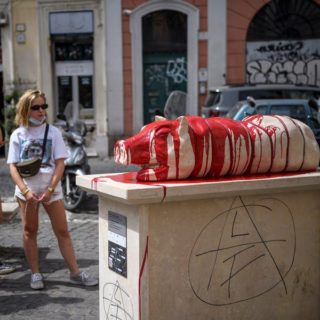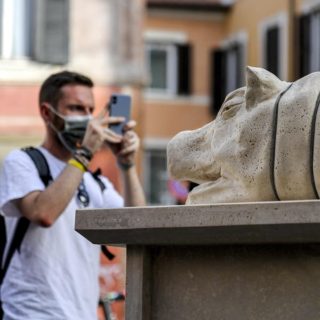ROME — The new artworks in eight of central Rome’s public squares are meant to be playful celebrations of the city’s rich culture and history. But some very vocal people do not see the whimsy in a dead pig.
The installations, unveiled last week, include an oversize rendering of Rome’s ubiquitous drinking fountains and a giant wooden doorstop, acclaiming Rome as an open city. And then there is the statue of a boneless roasted pig, a regional delicacy known as porchetta, denounced by outraged animal rights activists as a celebration of cruelty.
On Friday, the statue was removed only hours after it had been vandalized with cherry-red paint, which had been liberally dripped over the pig’s head and back. “Unfortunately, it came to this,” said Amedeo Longo, 24, the artist who created the work. “My heart is heavy.”
The artist looked on forlornly as city workers trussed the two-ton sculpture — titled “From the Sandwich to the Square” — which had been installed exactly a week ago on Piazza San Giovanni della Malva, in the trendy Trastevere neighborhood. It was hoisted by a crane onto a truck and driven to a municipal deposit.
The vandalism follows other protests this week, when shouting demonstrators picketed the work. They attached posters to its pedestal that read “Animals ARE NOT sandwiches” and “Your TRADITIONS, their SUFFERING”; brandished banners with slogans like “Animals are our brothers”; and demanded that the city take the statue away.
“I see nothing artistic in the death of an animal, put on exhibit,” said Rita Corboli, the Rome representative of the Italian branch of the International Organization for Animal Protection. “We absolutely want it to be removed.”
Even porchetta-loving Roman citizens, of whom there are many, gave voice to their inner art critics. Insults swelled the Facebook pages of the municipal ward and that of its president, Sabrina Alfonsi, who removed a photograph of the pig from her page (though the statue now has its own social media presence).

The porchetta sculpture, “From the Sandwich to the Square,” was vandalized with cherry-red paint on Friday in Rome. Antonio Masiello/Getty Images
“He didn’t create a work called ‘I Love Porchetta,’ he created a work of art that everyone was free to interpret,” Ms. Alfonsi said at a hastily convened news conference in the square. “Gestures of intolerance are inadmissible, whether they are against a work of art, or animals, or persons and our entire planet.”
She said the work was being removed so it could be restored. Its fate would be known “in a few days,” she added.
Mr. Longo said he was genuinely surprised by the response. He had just wanted to depict something quintessentially Italian.
His sculpture, made of Roman travertine marble, which has been used since ancient times, “was misunderstood,” he said, adding, “No animal was killed to make this sculpture.”
Public art often stirs critical passions, and contemporary art has often struggled to find space in Rome, a city steeped in hallowed history. A statue commemorating Saint John Paul II was so loathed when it was unveiled that the police had to be called in to protect it. (It later got a makeover.) And it took years for William Kentridge’s 2016 “Triumphs and Laments,” an ambitious public art project along the banks of the Tiber River, to get authorized.
The porcine fracas has overshadowed the spirit of the project, an effort to enliven Rome’s lesser-known squares with contemporary art, while giving opportunities to young, relatively unknown artists.
The eight works are by students of the Rome University of Fine Arts, or RUFA, and the inauguration included performances by musicians studying at the Santa Cecilia Conservatory and students from the national dance academy. The installations are temporary and will be removed at the end of August.
Several young people milled about the porchetta statue one sweaty evening this week, taking photographs and cracking comments.

The statue has attracted enormous attention, overshadowing other new public artworks. Riccardo Antimiani/EPA, via Shutterstock
Salvatore Tedesco, a graduate of Milan’s Bocconi University, who was perusing the statue with two friends, said he was not a fan. “We were just commenting on how beautiful every building is — how Rome is full of history and culture.” In comparison, the statue is an eyesore, he said.
His Bocconi schoolmate, Calogero Rallo, who now works in Luxembourg, disagreed, saying the statue was an ironic statement on tradition. “Everyone loves porchetta, so it is right that it be immortalized in stone like the Emperor Augustus,” he said. “A Roman institution deserves a statue.”
Actually, porchetta is more typical of the Castelli Romani, towns like Ariccia and Marino just southeast of Rome. Several passers-by said the statue would find a better home there.
“The bus for Ariccia is waiting,” joked a retired insurance salesman, Giuseppe, who declined to give his last name. But he grew nostalgic remembering how pork got his family of 11 through many winters when he was child in the highlands of Sardinia. The annual slaughter of a pig was almost a ritual, he said, adding, “There was respect for the animal.”
If nothing else, the statue has stimulated public debate, which is what contemporary art should do, said Giulia Urso, the ward councilor who oversaw the project. It has people arguing not only about public art, but also about the need to shift society “toward a more vegetarian and animal rights point of view,” she said.
Fabio Mongelli, the director of RUFA, said that both staff and students were frustrated that the porchetta polemics had eclipsed the other works in the project and its overall theme, capturing snippets of Rome’s rich identity. The 13 students involved in the project spent months working on it, including research into the history of Rome and events tied to the individual piazzas “to then give their interpretation looking to the future of the city,” he said. “It’s an act of love.”
Emiliano Coletta, an artist and visual arts professor at the university, said that he and Mr. Longo had gone to meet with the animal rights protesters, to have “a civil dialogue.”
“I can understand that not everyone can like the work, but frankly, it bothered me that it came down to speaking about porchetta,” Mr. Coletta said. “We’re a fine arts academy after all.”
His colleague, the artist Davide Dormino, who teaches sculpture, said that critics had missed the message of conviviality the statue conveyed. Porchetta was a street food, he said, “it unites people.”
“Had it been real,” Mr. Dormino added, “we would have been cutting slices and eating it.”
But public art is always a gamble, he said, and “artists have to know that public space belongs to everyone and that people have the right to express opinions.”

A man holding a sign saying, “Let’s defend them,” during an animal rights protest against the sculpture on Tuesday. Riccardo Antimiani/EPA, via Shutterstock
Simone Pizzani, a waiter at a restaurant on the same square as the statue, said the work was rather gloomy. “Maybe it would have been more fun had the pig been standing, smiling, holding a sandwich in his hand,” he suggested.
Mr. Longo said he was happy to have gotten the opportunity to show his work in public and that criticism was part of the game. “There are going to be people who like it and others who don’t,” he said.
As the statue was driven away Friday, one passer-by called out, “Great decision,” which prompted a very lively debate (argument) among those present in the square.
“I didn’t do anything wrong,” Mr. Longo said. “People continue not to understand the work, especially people who don’t want to understand this work, they have their ideals and they continue to have them. Unfortunately, I am no one. I am not going to be the person who changes their minds.”
FEATURED IMAGE: A sculpture of a roasted pig, a new public artwork installation paying tribute to the Italian capital, was removed on Friday after the statue was vandalized with cherry-red paint. Riccardo Antimiani/EPA, via Shutterstock
By Elisabetta Povoledo/The New York Times








